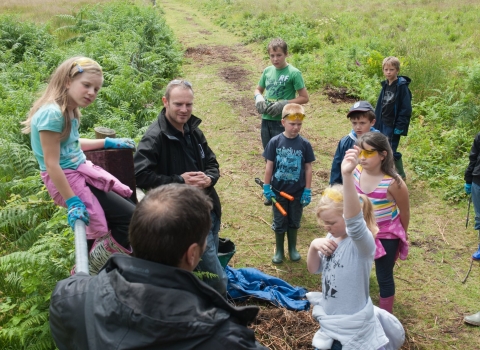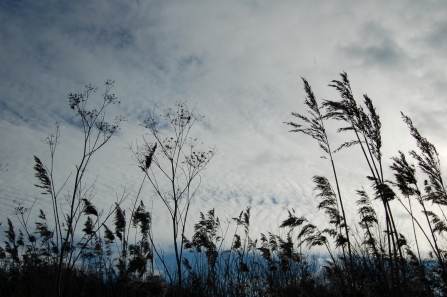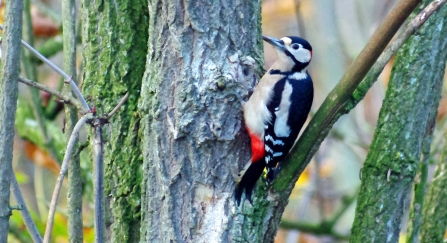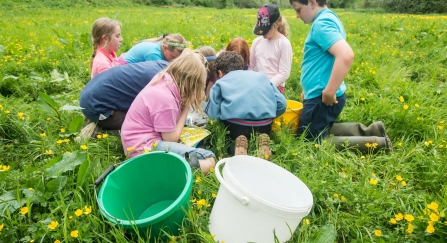Are you going to flood the area?
No. The Great Fen will actually help to reduce the risk of flooding in the local area; it has the potential to provide extra water storage during extreme rainfall, helping to protect local houses, farms and businesses. Woodwalton Fen National Nature Reserve is currently used as a flood storage area which is detrimental to this fragile remnant of fen biodiversity. The Project Partners are looking at how and where floodwater can be effectively stored elsewhere within the Great Fen.
Within the Great Fen area, where land is being restored, water is carefully controlled to create a range of wildlife habitats and to protect surrounding farms, houses and infrastructure.
In some areas, dry meadows will be created, and pockets of scrub and woodland will develop. To create open water, reedbed and wet meadows, the water level below the surface will be raised in those areas. In a wet meadow, for example, the raising of the water level will create more moisture and some pools, particularly in the winter, providing feeding grounds for birds.
Why is extra flood protection needed?
As the climate changes, it is predicted that there will be more extreme periods of heavy rainfall, leading to an increased risk of flooding when water can’t be pumped out to sea fast enough.
Flooding is a particular risk in the fens, which is flat and low-lying - many areas are below sea level. For farmers, businesses and communities, the effects of flooding can be devastating and costly.
Currently in the area of the Great Fen, Woodwalton Fen is used to temporarily store water during heavy rainfall. However, there are two problems:
Firstly, Woodwalton Fen is too small to cope with the more extreme rainfall events predicted in the future.
Secondly, the flood water often contains nitrates and phosphates from the surrounding farmland, which interferes with the sensitive ecosystem at Woodwalton Fen - an internationally important wildlife site. The water often comes at the wrong time of year for the wildlife too.
Are you taking farmland out of production?
Arable farming of onions and root vegetables has been successful in the fens because of the peat soil, known as 'black gold' which formed over thousands of years. Tilling the soil causes the peat to oxidise (erode away) - at a rate of about 2cm each year. If this continues, most of the peat in the Great Fen area will eventually be gone forever and the land will become less productive for root crop farming as a result. By providing natural plant cover, and re-wetting the peat the Great Fen will stop this peat loss.
The arable land in the Great Fen area (approx. 3700 hectares) constitutes just 0.019% of the agricultural land in Britain. To put this into context there is nearly a quarter of a million hectares of non-set aside land in the UK growing crops for non-food uses.
The diversification of the rural economy has become imperative to enable rural communities to survive. As well as arable crops, the Fens can provide a wide range of other goods and services to contribute to economic development.
Farming will still be taking place on the Great Fen but in a different way to the intensive arable crop production. The Great Fen will become a low-intensity food producer - with beef from grazing cattle, lamb from grazing sheep. It will also be providing other products. For instance, Great Fen land provides high-quality hay for livestock feed from the grassland. Local farmers also graze sheep and cattle on the land thus in turn producing beef and lamb for the public food market. In the future, the Great Fen may also be able to grow a local source of willow, and reed for thatching houses and for biofuels. The majority if thatch in Britain is imported from Eastern Europe or China because phosphate pollution has weakened our own reed. Farming these products preserves the peat soils and aids the restoration for wildlife. The Great Fen already offers opportunities for farmers and agricultural businesses to develop new sources of income and these will expand in the future as the Great Fen matures.
Will higher water levels affect the railway?
Where land is being restored, water is carefully controlled so that there are no impacts on neighbouring land, homes, businesses or infrastructure. The railway is no exception. Negative impacts on the railway are not allowed. The design of the new reedbed next to the railway is such that a buffer zone has been created between the reedbed and the railway line, in addition, water levels are the movement of water up and through the soil is carefully monitored.
How can the project help to protect us from climate change?
The Great Fen can play its part in helping nature to adapt to the effects of climate change and in mitigating the impacts of climate change on the environment, people and communities.
By creating new areas of habitat that are linked one to another, the Great Fen gives wildlife more room to spread and to move. Some species that prefer warmer climates in the south are now moving north, and so the Great Fen can provide a new home or a staging post in that process.
The Great Fen can also help to reduce the emission of some greenhouse gases (one of the factors in driving climate change) in particular through halting the process of peat degradation. It has been estimated that the oxidation of peat in the Great Fen area releases 325,000 tonnes of Carbon Dioxide per annum (The Open University; 2008), the equivalent of being able to offset the carbon emissions of 54,000 local householders every year.
The loss of peat through oxidation is a direct result of drainage of the land. Once the peat is re-wetted and oxidation is stopped, greenhouse gasses can be greatly reduced. It is possible that conditions will allow for peat-forming processes to become re-established, locking up carbon from the atmosphere rather than releasing it. There is much more to be learned, but the Great Fen is a positive story in the fight against climate change. Locking up the remaining carbon in the peat that still remains and reintroducing peat-forming processes, is one of the key objectives of the Great Fen. Over 80 years, it is predicted that each rewetted hectare of Great Fen could result in an avoided loss of 10,000 tonnes of CO2
One impact of climate change are more, and more extreme, weather events leading to winter and summer flooding. The Great Fen has the potential to provide extra water storage during extreme rainfall, helping to protect local houses, farms and businesses.
Will you force landowners to sell their land?
No. We can only achieve the Great Fen’s aims either by buying land or working in partnership with existing landowners. Landowners do not have to sell their land if they do not wish to. This is why the project is a long-term one, as opportunities for purchasing land do not come up very often.
Will foundations of homes be affected?
Properly constructed buildings in the Fens are built in such a way that peat shrinkage does not affect the foundations. Typically this is done by piling through the peat to the clay beneath. Because of this, changing hydrology in the Great Fen area will not have a significant impact on the buildings there. In areas under restoration, water levels are carefully controlled and no impacts are allowed on buildings and structures.
Is there a threat from Malaria?
- The presence of the malaria parasite
- A carrier of the disease - certain species of mosquitoes
- Habitats for the mosquitoes to breed
- Suitable temperatures for the mosquitoes and the malaria parasite
First of all it should be noted that conditions for malaria in the fens have always existed, and still exist, yet Malaria has long since disappeared. This is due to a number of reasons:
Changes in lifestyle. One of the main carriers of malaria in the fens was the Anopheles maculipennis group. This group of mosquitoes has to survive winter in the adult form. When malaria existed people and stock lived in very close proximity and this enabled the mosquito to move between humans and animals and feed enough to get through winter. Although some livestock is now returning to the Great Fen, times have changed, and people and cattle no longer live cheek by jowl in the winter. Cattle are kept quite separately from humans. Obviously, the more wetlands (of certain types), the more mosquitoes there will be. The Great Fen will be creating a variety of wetlands and some of these will enable the mosquitoes to breed. However, these habitats already exist in the fens in general and in the project area. Overall the increase mosquito population relative to current levels is unlikely to be significant.
Mosquito survival. In temperate regions such as the UK, mosquitoes feed roughly once every three weeks. Survival of the mosquito for this length of time is not guaranteed. The malaria parasite has also to have matured enough to infect the next person. This is not guaranteed. Furthermore, winter freezing kills off many mosquitoes and eggs, preventing a sustained outbreak of malaria. There are some 2000 cases of malaria in the UK each year. All but about 60 of these people contract the disease whilst in a foreign country. These cases are typically found in areas of the country where there is a large population of people from tropical regions. The remaining 60 people are often found near airports and were probably affected by mosquitoes that arrived in the country by plane.
How is the Great Fen funded?
The Great Fen has been made possible thanks to the generosity of many individuals, organisations and funders. Funding for work across the Great Fen, including land purchase, restoration and education and community work has come from a variety of funders, organisations and sources.
This includes the Project Partners, Grant Giving Trusts, Landfill tax, EU funding (such as Interreg and LIFE programmes) business sponsors, individual and private donors, and most significantly, the Heritage Lottery Fund. The Great Fen has been awarded over £9 million by the HLF; in 2007 a grant of £7.2 million (the largest grant ever given to an environmental project) and in 2013 a further grant of £1.89m.funding work up to the end of 2016.The level and spread of this financial support shows the confidence funders have in the Great Fen and its ability to deliver what it promises. It also reflects the national and international standing of the Great Fen as a cutting edge landscape scale conservation project.
Fund raising is a constant activity of the Great Fen, and will always be important, but in the future it will not be the only income stream for the Great Fen. The new ways of land management and the new income streams arising from it, the development of a tourist economy, and the development of business opportunities will all help to sustain the Great Fen and the local community in future years, ensuring that the Great Fen will be here for the long term, continuing to offer a unique wild landscape for people and nature.
Have local people been consulted?
We want to make sure that the Great Fen benefits local people and feel that it is vital that we seek the views and advice of local people. The Great Fen can only be achieved and sustained with the support of local people and communities.
The team have been consulting local people about many aspects of the Great Fen, including activity programmes and the Great Fen Masterplan. The Masterplan was written in consultation with local people, farmers, businesses, and other stakeholders, gathered through a wide consultation exercise. This included:
- 19 events at public venues, where the Project Partners received feedback from over 270 people;
- 16 information points at libraries and information centres between Peterborough and Huntingdon;
- 260 questionnaire responses received and analysed; and
- Consultation with local organisations, public bodies, and specialist groups such as Disability Cambridge, The British Horse Society, English Heritage, The National Union of Farmers, and Sustrans.
This consultation continues, and the frequently meet representatives with specialist groups, including farmers, business people, people with disabilities, young people, local horse-riders, business and tourism specialists, and local schools. The Great Fen has also created a Community Forum which meets annually to exchange news and views.
Will the scheme halt housing development in the area?
As the land we are interested in is at or below sea level, there is very little development. Most buildings are found on small areas of land that sit at or above sea level. Certainly the area wouldn't be a candidate for large scale housing developments. The Great Fen is about restoring a landscape, and in that landscape people would have lived and worked. Therefor we expect people to live and work in the area in the future. A large scale housing development is being planned by developers at Alconbury Weald outside of the Great Fen.
Will the Great Fen stop businesses developing and people making a living?
No, not at all. One of the aims of the Great Fen is to promote economic development within the Great Fen, development that is sustainable, offers business and training opportunities to local people and which complements the new landscape. The Great Fen is working closely with Project Partners, farmers, local businesses and business organizations to develop a Great Fen economic development strategy and routemap, setting out in a clear and sensible way actions that can be taken to achieve economic development and opportunity within the Great Fen. One key element will be the development of a tourist economy as more and more people will visit the Great Fen as it matures. These visitors will need all the usual services, such as places to stay, places to eat, things to do and see, ways to enjoy the Great Fen and to get close to nature. The future will therefore offer many opportunities. Progress is already being made in developing sites and facilities for visitors; the Great Fen opened its first Visitor Information point at New Decoy Farm in 2012, and completed a RIBA Open Ideas Design competition for a new Visitor Centre in last year. The Great Fen is also able to offer skills training and work experience through its volunteering programme. This is an area that will be expanded in the future.
What is the timescale for the Great Fen?
The Great Fen is open-ended. The Great Fen Masterplan illustrates a 50 year vision of what the Great Fen could look like. Some aspects of the Masterplan, such as the proposed visitor centre, may be possible to develop in the not too distant future, subject to funding.
Other elements, such as the full network of paths and facilities, will take longer and require close co-operation with other land owners and organisations in the area to achieve.
It is likely to take a number of decades to acquire all the land due to the scale of the area, cost, and the need to wait until landowners voluntarily wish to sell their land.
However, a huge amount has already been achieved, even in the first decade of the Great Fen. More than 50% of the land is now owned by the Great Fen partners. See History of the Great Fen project for more information.
Click the image below to discover the Great Fen Masterplan for the future.
Is the Great Fen connected with the Wicken Fen Vision and other fen restoration projects?
Wicken Fen, along with Woodwalton Fen and Holme Fen in the Great Fen area, is one of the few remaining fragments of what was previously 1,350 square miles of wild fens. More than 99% of the ancient fens have disappeared.
The history of Wicken Fen and Woodwalton Fen are linked as they were both established as nature reserves and protected from drainage in the early 1900s after they were acquired by Sir Charles Rothschild. The Wicken Fen vision to expand the reserve is being led by the National Trust.
Both projects deliver a variety of benefits, including wildlife conservation, a space for people, and flood risk management. Together, and alongside other restoration initiatives such as the RSPB/Hanson project at Needingworth, and Lincolnshire Wildlife Trust’s project at Thurlby and Baston, they will significantly raise the profile of the Fens in East Anglia and East Midlands. Best practice is shared across the projects.
What wildlife are you hoping to attract?
Woodwalton Fen and Holme Fen protect many thousands of species of plants and animals, some of which are very rare, such as the Fen Violet and Fen Woodrush.
The reserves are too small in their current size and are affected by the way land around them is managed. To attract a variety of wildlife, a mosaic of fen habitats will be created, including meadows, reedbed, woodland and open water.
Species that will benefit include mammals (including Otters and Water Voles), birds (including nationally declining birds such as Snipe and Lapwing) and insects including dragonflies, butterflies and moths, and water beetles.
In the future, we hope that new species will establish in the Great Fen, such as Common Crane, which disappeared from the area few hundred years ago due to hunting and loss of habitat.
Click the image below for further information about wildlife at The Great Fen.
Is there access for people with disabilities and pushchairs?
Yes. Different parts of the Great Fen have different levels of access. There are also a range of facilities and equipment for free hire to aid people with disabilities, including portable hearing loops, a tactile mp3 player for audio guides, and an all terrain-Tramper.
The Wildlife Trust Countryside Centre provides a wide range of facilities, including blue badge holder parking spaces, toilet (including an accessible toilet and baby changing) and an 800m Discovery Trail on grass paths, which has no steps, gates or stiles.
Explore more on Ramsey Heights by clicking the image below.
Health and Safety on our reserves
We hope everyone who visits our reserves has a fantastic time, however like all natural environments there are a few things to watch out for. The ground around the reserves may be uneven, wet and slippy at times. Animals, such as rabbits, like to dig holes. So it is important to watch your footing as you walk around. There may also be deep water.
Being a wetland reserve during spring and summer months we also have lots of biting insects so please wear trousers and long sleeve tops and bring some repellent during this time. Additionally, as deer inhabit many of our reserves, ticks are a possibility. Ticks also inhabit urban parks and gardens. Wearing trousers and long sleeves is also the best defence against this as well as sensible shoes, but also check for ticks after your walk and for a few days afterwards. If you do find any ticks on yourself or a pet consult a health care professional before removing.
Please also wash your hands before eating and drinking (bringing alcohol hand gel is a good idea). There are a number of poisonous plants around the reserves and diseases, such as Weils Disease, are present in the water.
These are all very low risk hazards, but taking precautions when visiting any nature reserve is a good idea to ensure you have a enjoyable day out.
How can I get involved?
There are many ways to get involved and support the Great Fen. You can come to an event, volunteer, donate and much more. You can find out more ways to get involved by clicking on the image below.



